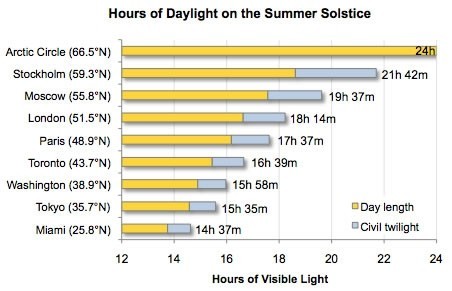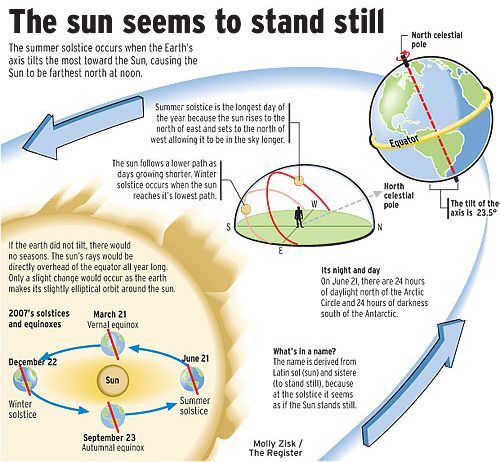A few interesting factoids about the Summer Solstice:
1. Its the 1st day Of Summer (in the Northern Hemisphere)
2. The Summer Solstice is also the Winter Solstice (in the Southern Hemisphere).
3. This year, it falls on June 21. But that’s not always true. It occurs when the sun reaches its highest point in the sky. It varies between June 20-22.
4. The word “Solstice” is means “sun” and “staying,” or “the sun standing still.”
5. Around noon on the solstice, your shadow will be the smallest it is all year.
6. In some places, there’s constant sunlight.
7. Solstice has been celebrated for centuries.





Q. Why do Australian seasons start on the 1st of the month?
————-
A. Australians start the change of season on the 1st of the month. Summer 1st December, Autumn 1st March, Winter 1st June, Spring 1st September.
Many countries (especially Northern hemisphere) start their seasons on the equinox or solstice dates.
Why is Australia different?
Did we ever have our seasons dates start mid-month or did the First Fleet dictate the 1st of the month?
If we started mid-month when did it change to the 1st of the month?
————————-
Best AnswerAsker’s Choice
* Au T answered 7 years ago
*
In countries such as the UK, Denmark, Ireland and Australia the seasons are simply decided according to the Roman calendar, with the seasons decided by the hottest / coldest quarters of the year and beginning on the first of the month.
So Autumn – March 1st
Winter – June 1st
Spring – September 1st
Summer December 1st
and reverse for the opposite hemisphere.
For countries such as the United States, the seasons are determined Astrologically – and begin at the solstice and equinoxes. So spring begins when the days hit equal length then get longer, autumn when they hit equal length then get shorter etc.
Thus spring – March 19 – 22 – the spring equinox
Summer – 19 – 23 June – the summer solstice
Autumn – 21 – 24 Sept – the autumn equinox
Winter 20 – 23 Dec – the winter solstice
and vice versa for the opposite hemispheres.
Since the idea of four seasons was imposed on the rest of the world by northern Europeans and north Americans, there has been dispute about the start of the seasons. Most countries that subscribe to the four season idiocy start them on the solstices and equinoxes. Australia starts them on the first of the month.
My investigations have found a possible reason for this although it could well be apocryphal. The NSW Corps changed from its summer to winter uniform on the first of March and from its winter to its summer uniform on the first of September. The starting dates for the other seasons followed this.
It is much easier for record keeping if the seasons start on the first of the month rather than an arbitrary date between the 20th and 23rd. The Bureau of Meteorology certainly likes starting the seasons on the first.
Seasons were named and identified long before anyone knew that the Earth revolved on its axis, that the axis was tilted or that the earth orbioted the sun. They were identified from the behaviour of animals and plants and from the weather. Northern Europe settled on four seasons. In Australia, there are five named and identified seasons in the Kimberley, six in the Darwin/Kakadu area and the Wik people of Cape York have eight. Each of these is just as valid as the northern European four.
https://au.answers.yahoo.com/question/index?qid=20080229173950AAvc9ZE
Midnight golf in Sweden!!!!!
>3. It occurs when the sun reaches its highest point in the sky.
More accurately, when the sun is the farthest north in its apparent journey through our skies.
>6. In some places, there’s constant sunlight.
I.e., as the diagram indicates, at latitudes north of the Arctic Circle. At latitudes south of the
Antarctic Circle, the sun remains below the horizon all day.
8. While (in the Northern Hemisphere) the Summer Solstice is the longest day of the year, it is
neither the day of the earliest sunrise (which occurs about a week earlier) or the latest sunset
(which occurs about a week later). This is largely due to the eccentricity of the Earth’s orbit,
which is an ellipse, not a circle.
9. The seasonal changes in weather are due to the Earth’s axial inclination and hence the
Sun’s position in the sky, which results in more or less radiant energy per square foot reaching
the ground. In fact, the Earth is relatively far from the Sun on the Summer Solstice, as aphelion
is July 6th. (Perihelion, the point when the Earth is closest to Sun, was January 4th.)